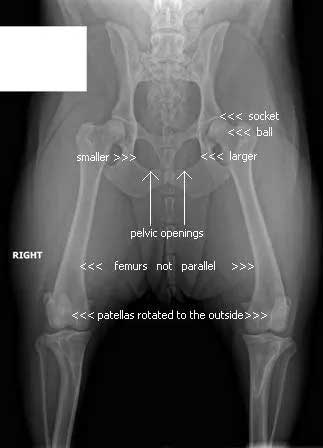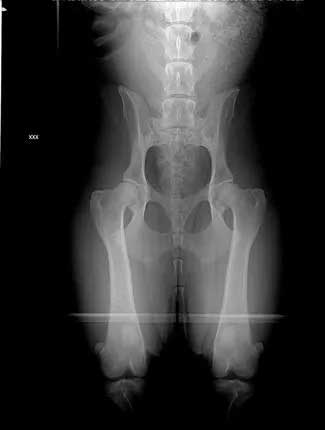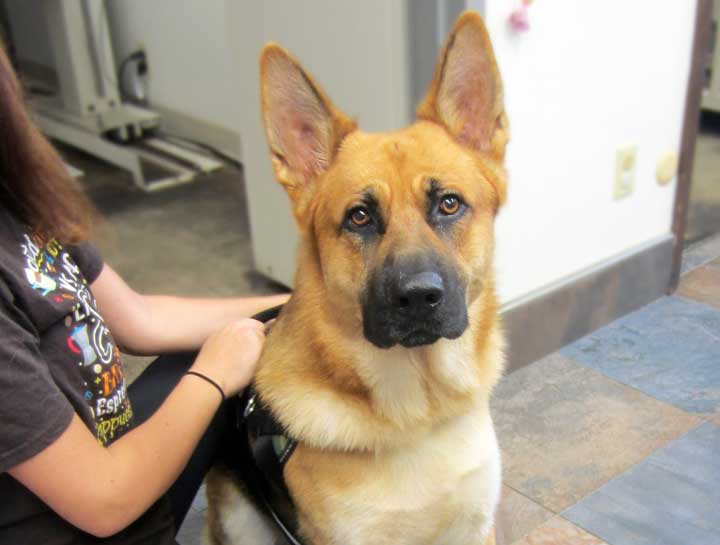Case studies
Dr. Davis' research results.
After analyzing the data I had received from my survey, I concentrated my first case study on the group of dogs that had received failing grades with subluxation (the ball not being deep enough in the hip socket) as the only reason. Some of these dogs had one-sided (unilateral) subluxation while others had two-sided (bilateral).
As you can see from the table below of data compiled from my survey, when the only comment was failing because of subluxation- unilateral or bilateral- I achieved a 92% passing rate when I retook and resubmitted the dog’s x-rays. The tattoo or microchip number was verified each time to ensure it was the same dog being x-rayed.
|
No. |
Breed |
Previous Grade |
New Grade |
Grades Changed |
| 1 | Golden Retriever | borderline | good | +2 |
| " " (same dog) | fair | +1 | ||
| 3 | Golden Retriever | mild dysplasia | good | +3 |
| 4 | Golden Retriever | mild dysplasia | good | +3 |
| 5 | Labrador Retriever | mild dysplasia | fair | +2 |
| 8 | Labrador Retriever | mild dysplasia | good | +3 |
| 14 | Shetland Sheepdog | (fail) | fair | +1 (at least) |
| 16 | Rottweiler | (fail) | fair | +1 (at least) |
| 23 | Golden Retriever | (fail) | fair | +1 (at least) |
| 24 | Labrador Retriever | * | good | +2 (at least) |
| 25 | Rottweiler | moderate dysplasia | mild dysplasia | +1 |
| 26 | Standard Schnauzer | mild dysplasia | good | +3 |
| 28 | Bernese Mountain Dog | * | fair | +1 (at least) |
| 29 | Golden Retriever | mild dysplasia | fair | +2 |
| 31 | Golden Retriever | mild dysplasia | fair | +2 |
| 32 | Golden Retriever | moderate dysplasia | good | +4 |
| 34 | Golden Retriever | moderate dysplasia | mild dysplasia | +1 |
| 35 | Golden Retriever | borderline | good | +2 |
| 37 | Golden Retriever | borderline | good | +2 |
| 39 | English Springer Spaniel | mild dysplasia | excellent | +4 |
| 40 | Golden Retriever | * | fair | +1 (at least) |
| 43 | Bullmastiff | mild dysplasia | fair | +2 |
| 44 | Golden Retriever | mild dysplasia | good | +3 |
| 46 | Golden Retriever | mild dysplasia | good | +3 |
| 49 | Afghan Hound | mild dysplasia | fair | +2 |
| 50 | Rottweiler | mild dysplasia | fair | +2 |
| 52 | Labrador Retriever | mild dysplasia | good | +3 |
| 53 | German Shepherd | mild dysplasia | fair | +2 |
How, then, can this change in grade happen?
 As an example, look at the following radiograph brought to me by an owner.
As an example, look at the following radiograph brought to me by an owner.
This x-ray was taken by another veterinarian and submitted to O.F.A. for evaluation. The film was accepted by O.F.A. and received a grade of mild dysplasia. Notice how the long bones (femurs) are not parallel, the kneecaps (patella) are rotated to the outside and one side of the pelvic opening is larger than the other (the pelvis is tilted).
Now, look at the x-ray I did. This film was also submitted to O.F.A. and received a grade of good. Notice the difference in the appearance of the hips from the first film to the second. It’s the same dog but different positioning. In the second film, the femurs are nearly parallel and the patella is rotated inward and centered. Just by changing how the dog was positioned, the O.F.A. grade improved from mild to good.
 Which of these films most closely matches the recommendations for positioning as set forth by O.F.A. on their website here and here?
Which of these films most closely matches the recommendations for positioning as set forth by O.F.A. on their website here and here?
To read the full text of my study about the variation in O.F.A. grades in dogs with unilateral or bilateral subluxation only, click here.
To read a second study I did based on this survey which compares O.F.A. grades received when a dog is radiographed awake, sedated, or anesthetized, click here.

